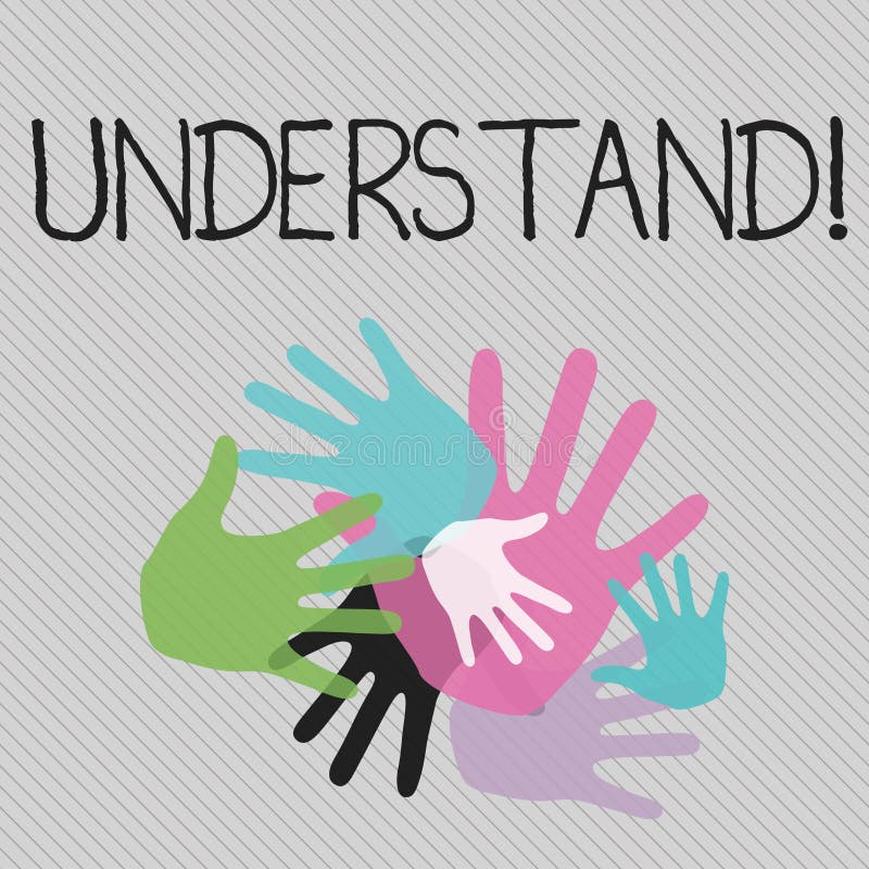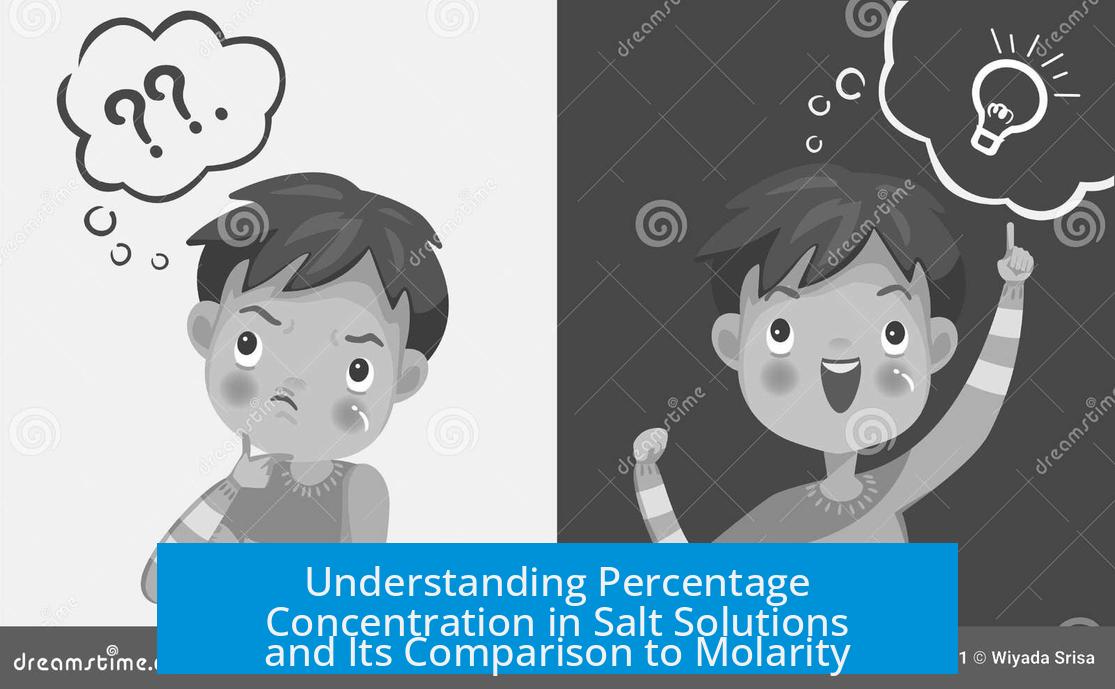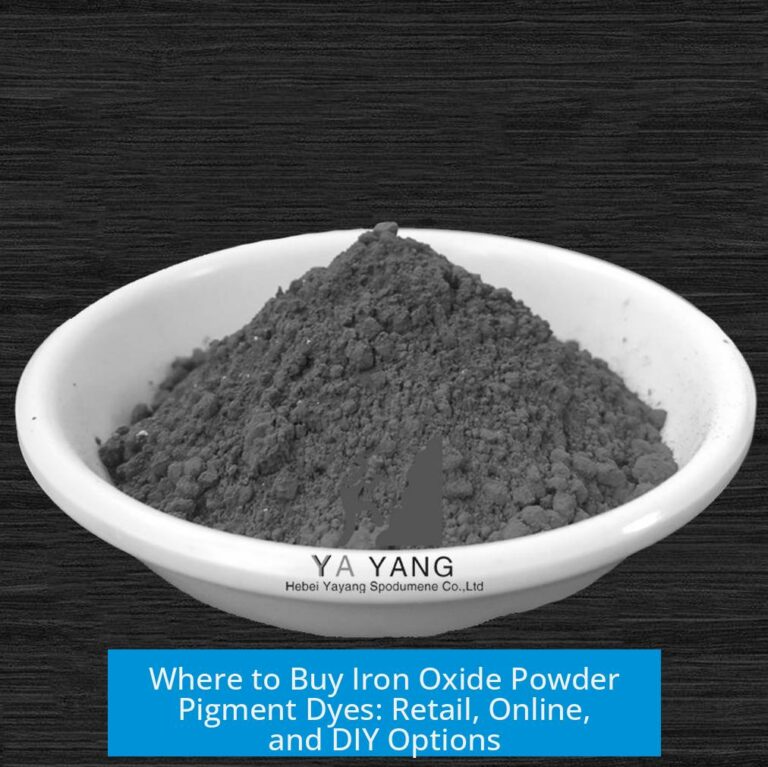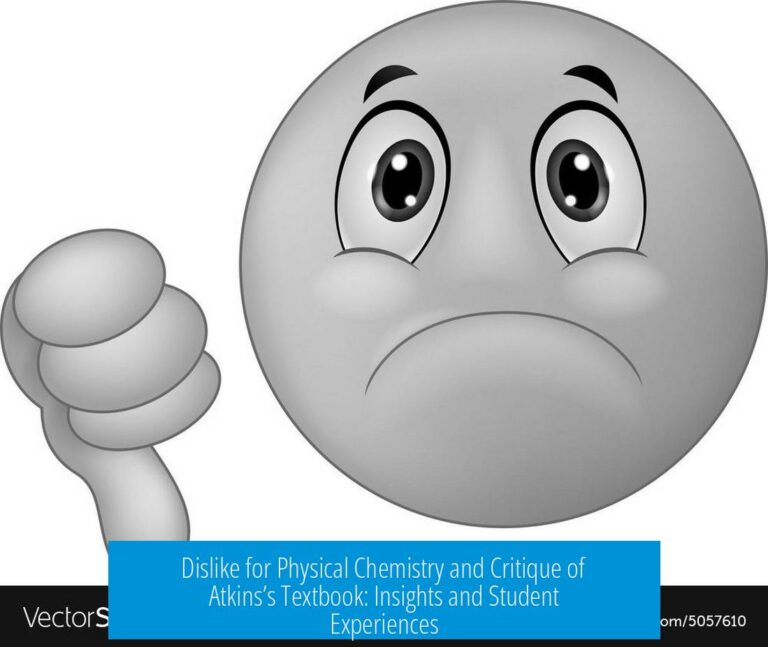Understanding Percentage Concentration in Salt Solutions
 When someone says the concentration of a salt solution is a percentage instead of a molarity, it means they are expressing the amount of solute relative to the total solution by mass or volume, rather than by the number of moles per liter. This reflects how much of the solution consists of the dissolved salt, but it does not directly provide the molar concentration, which accounts for the quantity of molecules or ions present.
When someone says the concentration of a salt solution is a percentage instead of a molarity, it means they are expressing the amount of solute relative to the total solution by mass or volume, rather than by the number of moles per liter. This reflects how much of the solution consists of the dissolved salt, but it does not directly provide the molar concentration, which accounts for the quantity of molecules or ions present.
This article explains what percentage concentration means, how it differs from molarity, and the implications for practical measurements and chemical understanding.
1. What Does Percentage Concentration Mean?
The term “percentage concentration” generally refers to the fraction of a particular component within a solution expressed as a percentage. Several commonly used definitions exist:
- Mass Percent (wt%): The mass of the solute divided by the total mass of the solution, multiplied by 100.
- Weight/Volume Percent (w/v%): The mass of solute (in grams) per volume of solution (in milliliters), multiplied by 100.
- Volume/Volume Percent (v/v%): The volume of solute divided by the total volume of solution, multiplied by 100.
| Type | Definition | Example |
|---|---|---|
| Mass Percent (wt%) or (w/w%) | (Mass of component / Mass of total solution) × 100 | 20 g salt + 80 g water → 20% wt% solution |
| Weight/Volume Percent (w/v%) | (Mass of solute in grams / Volume of solution in mL) × 100 | 20 g NaCl in 100 mL solution → 20% w/v |
| Volume/Volume Percent (v/v%) | (Volume of solute / Total volume of solution) × 100 | 20 mL ethanol + 80 mL water → 20% v/v |
Mass percent (wt%) is the most common percentage concentration used to describe salt solutions.
2. How Does Percentage Concentration Differ From Molarity?
Molarity describes the concentration in terms of the number of moles of solute per liter of solution (mol/L). It directly relates to molecular amounts, requiring knowledge of molecular weight and solution volume.
Percentage concentration, however, expresses solute quantity by mass or volume proportion without direct reference to moles. For example, a 10% salt solution by mass means 10 grams of salt per 100 grams of solution, but it gives no direct information about the number of moles dissolved.
Because percentage does not inherently involve molar quantities, it lacks the precision required for some quantitative chemical calculations. Molarity is essential for stoichiometric calculations and titrations where exact reactant amounts matter.
3. Practical Implications of Using Percentage Concentrations

- Mass-based percentages are most reliable: Salt solution preparation usually involves weighing solids and liquids because mass does not change with temperature.
- Volume-based percentages can be misleading: Volumes are not always additive. Mixing solvents often results in volume contraction, so volume percentage can misrepresent actual concentrations.
- Easy preparation and communication: Percent concentrations require less precise equipment and are useful in non-laboratory or preliminary contexts where molecular detail is unnecessary.
- Limited precision for analytical chemistry: When accurate determination of active species concentration is critical, molarity or molality should be used over percentage.
For example, dissolving 20 grams of salt in enough water to make 100 mL of solution gives 20% (w/v), but the actual molarity depends on the salt’s molecular weight and the final solution volume.
4. Ambiguities and Limitations of Percentage Concentrations
Percentage concentration terms can be ambiguous if units are omitted or unclear. Without specifying whether it is weight/weight, weight/volume, or volume/volume, the value lacks precise meaning.
Many chemicals, including salts, have solubility limits that restrict maximum achievable concentrations. For instance, sodium chloride saturates around 26% by weight at room temperature. Claiming a 50% concentration physically is impossible and often signals misunderstanding or that the term refers to saturation or another measure.
The phases of solute and solvent impact the apparent volume or mass percentage. For solid salts in water, mass percent is most appropriate; for liquid solutes, volume percentages may be used, but require clarification.
5. Why Percentage Concentration Remains Popular
- Historical textbooks and basic chemistry education emphasize percentage because it does not require molecular weight knowledge.
- It provides a simple, intuitive measure of how much solute is visible in the mixture.
- Many industrial and commercial contexts label concentrations this way for ease of understanding.
Nevertheless, in any precise chemical process or laboratory measurement, molarity and molality supersede percentage due to their direct link to molecular quantities and reaction stoichiometry.
6. Summary Table: Percentage Concentration vs. Molarity

| Aspect | Percentage Concentration | Molarity |
|---|---|---|
| Definition | Mass or volume fraction multiplied by 100 | Moles of solute per liter of solution |
| Units | %, wt%, w/v%, v/v% | mol/L (M) |
| Requires molecular weight? | No | Yes |
| Precision in stoichiometry | Low | High |
| Practical use | Quick reference, easy preparation | Quantitative analysis, titrations |
7. Key Takeaways
- Percentage concentration expresses solute amount by mass or volume fraction, not mole number.
- Mass percent (wt%) is most common for salt solutions, defined as mass of solute divided by mass of total solution multiplied by 100.
- Molarity measures moles of solute per liter of solution, important for precise chemical calculations.
- Percentage values without units are ambiguous; always clarify w/w, w/v, or v/v.
- Volume-based percentages may not reflect true concentrations due to volume changes upon mixing.
- High percentage salt concentrations are limited by solubility; saturation percent is different from simple weight percent.
- Use molarity in analytical chemistry; use percentage for simpler, non-quantitative contexts.
When Someone Says the Concentration of a Salt Solution Is a Percentage Instead of a Molarity, What Exactly Does That Mean?
When you hear “the concentration of a salt solution is a percentage,” it means they’re expressing how much salt is present relative to the total mass or volume of the solution, rather than counting the actual number of moles of salt per liter. In simple terms, percentage concentration tells you how much salt by weight or volume is in the whole mixture.
But what does that really mean? And why do people talk about percentages instead of molarity—especially in chemistry?
Let’s unpack this common question with practical facts and examples that shine a light on this often overlooked but crucial detail.
Understanding Percentage Concentration: What’s on the Label?

When someone uses percentage concentration, they usually refer to how much salt mass or volume is present compared to the entire solution. The word “percentage” here is shorthand for different ways salts can be measured inside a solution.
Here’s the rundown of common types of percentage concentration:
- Mass Percent (wt% or w/w%): This is probably the most common type. It’s the mass of the salt divided by the total mass of the solution multiplied by 100. For example, a 20% (w/w) salt solution means 20 grams of salt are present in every 100 grams of solution — that includes both the salt and the solvent.
- Weight/Volume Percent (w/v%): This one means weight of salt per volume of solution. So, 20% (w/v) means 20 grams of salt dissolved in 100 milliliters of solution.
- Volume/Volume Percent (v/v%): Considered mostly for liquids, this is the volume of solute in relation to total solution volume. For instance, 20% (v/v) means 20 milliliters of solute mixed into 80 milliliters of solvent to make 100 milliliters of solution.
Less common types include volume/weight percentage (v/w%), but these are rare and usually avoided due to complexity.
Why Does Most Chemistry Stick to Mass Percent?
The default or go-to is mass percent. It’s nearly always percentage by weight because the mass of components is stable and easier to measure accurately than volume, especially when salts dissolve.
Salts don’t simply expand or shrink volume the way liquid solutes might. In case you mix two liquids such as methanol and water, the volumes don’t add up neatly due to molecular interactions. Chemists prefer mass since it avoids volume confusion.
“Make up and measure such solutions by weight” sums it up perfectly for lab work.
Now, How Is This Different from Molarity?
Molarity (M), the superstar of chemistry, measures the number of moles of solute per liter of solution. It tells you about the actual number of molecules present, which makes it useful for precise calculations in reactions and titrations.
Percentage concentration does not directly provide this information. You get an idea of “how much” by mass or volume, but without knowing the molecular weight of the salt and the exact volume of solution, it’s impossible to convert that percentage directly into moles per liter.
To calculate molarity from a percentage, you’d need the salt’s molecular weight and the total solution volume—otherwise, the numbers don’t line up for stoichiometry or detailed analytics.
Where Percentages Shine (And Where They Don’t)

- Good for Rough Estimates: If you’re mixing solutions casually—for example, salt water for an aquarium or household cleaners—percentage concentration is adequate.
- Not Ideal for Precise Chemistry: When accuracy matters—like in titrations, pharmaceuticals, or chemical manufacturing—molarity gives the clear, molecular detail percentages can’t.
- Legacy and Simplicity: Percentages date back to the days when exact molecular weights were less known or less important. It’s simpler to say “20% salt” than talk complicated moles.
- Ambiguity Factor: Beware! When someone just says “20% salt” without units, it’s ambiguous. Is it w/w, w/v, or something else? Always clarify.
A Little Chemistry Humor: Percentages Are for People Who Don’t Want to Be Chemists
It’s said in the lab: “If someone gives you only a percentage concentration without units or molecular weights, either they don’t like math, or you’re about to enter a messy calculation.”
In other words, percentage is a handy shorthand for everyday use but not your friend when diving deep into chemical reactions.
Does 50% Salt Solution Even Exist?
This is a great practical question. You might hear “50% salt solution,” but chemically, that’s usually impossible due to solubility limits. Salt water solutions saturate around 26% by weight, depending on temperature and pressure.
So when you see higher percentages, it might mean saturated solution percentages or something else entirely.
How to Convert Percentage Concentration to Molarity: A Quick Guide

If you want molarity from percentage, here’s a straightforward approach:
- Identify if the percentage is w/w or w/v.
- Calculate the mass of salt in grams from the percentage.
- Find the number of moles using the molecular weight of the salt (e.g., NaCl ≈ 58.44 g/mol).
- Measure or know the total volume of the solution in liters.
- Divide moles of salt by total liters to get molarity.
Example: A 20% (w/v) NaCl solution means 20 g NaCl per 100 mL solution. That’s 0.02 kg and 0.1 L.
Moles = 20 g / 58.44 g/mol ≈ 0.342 mol Volume = 0.1 L Molarity = 0.342 / 0.1 = 3.42 M
So, a 20% (w/v) NaCl solution corresponds to about 3.4 M.
Final Thoughts: To Percentage or To Molarity?
If you want a quick, simple way to describe how salty your water is, just say percent salt concentration. But if you’re planning experiments, safety checks, or chemical reactions where details matter, switch to molarity.
And when in doubt, double-check what that “%” really stands for. Is it weight or volume? Is the solution saturated? Clarify all this to avoid surprises.
Now, next time someone says, “This salt solution is 15%,” you’ll know exactly what they mean—and maybe impress them by asking “By weight or volume, friend?”
What does it mean when salt solution concentration is given as a percentage?
It means the amount of salt is expressed as a fraction of the total solution. Usually, this percentage is by mass, showing how many grams of salt are in 100 grams of solution.
How is percentage concentration different from molarity?
Percentage shows mass or volume ratio, not moles. Molarity tells the exact number of moles of solute per liter of solution, which is important for precise chemical calculations.
Can the percentage concentration be based on volume?
Yes. Sometimes volume/volume percent is used, like for liquid solutes. But volume percentages can be less reliable because volumes don’t always add up perfectly when mixed.
Why is percentage concentration considered ambiguous?
Because it can mean mass/mass, mass/volume, or volume/volume percentages. Without clear units, it’s hard to know exactly what the percentage refers to, causing confusion.
Is it possible to have a 50% salt solution by weight?
No, saturated salt solutions max out near 26% weight depending on temperature. A 50% weight salt solution usually indicates a misunderstanding or saturation percentage, not an actual concentration.





Leave a Comment